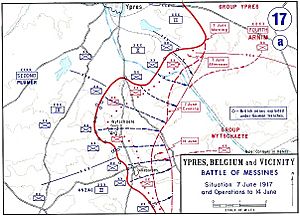Battle of Messines facts for kids
Quick facts for kids Battle of Messines |
|||||||
|---|---|---|---|---|---|---|---|
 Map of the battle. This shows the front on 7 June and all action until 14 June. |
|||||||
|
|||||||
| Belligerents | |||||||
|
|
|||||||
| Commanders and leaders | |||||||
| Strength | |||||||
| 12 divisions 216,000 men total |
5 divisions 126,000 men total |
||||||
| Casualties and losses | |||||||
| 17,000 | 25,000 | ||||||
The Battle of Messines was an important fight during World War I. It took place on the Western Front in June 1917. The battle started on June 7, 1917. It involved the British Second Army. This army was led by General Herbert Plumer.
The British forces attacked near the village of Mesen (Messines). This village is in West Flanders, Belgium. The main goal was to capture a high piece of land. This land was called a ridge. It stretched north from Messines village, past Wytschaete village. This ridge was a very good spot for defense. It offered a clear view and protection southeast of Ypres.
A very unusual tactic was used in this battle. Before the soldiers attacked, 19 huge mines were set off. These mines were tunnels filled with explosives. They were dug under the German defenses. When they exploded, they caused a lot of confusion. This helped the attacking troops move forward quickly. The Battle of Messines also happened before a much bigger battle. That battle was the Third Battle of Ypres, also known as Passchendaele. It began on July 31, 1917.
Contents
What Was the Goal of the Battle?
The main aim of the Battle of Messines was to capture the Messines Ridge. This ridge was a key defensive position for the German army. It gave them a strong advantage. From the ridge, German forces could see and control the area around Ypres. Taking this ridge would make it safer for Allied troops. It would also help prepare for future attacks. The British wanted to push the Germans back. They also wanted to improve their own positions.
Why Was the Ridge So Important?
The Messines Ridge was like a natural fortress. It was higher than the land around it. This meant that anyone on the ridge could see for miles. They could spot enemy movements easily. For the Germans, it was a perfect place to set up machine guns. They could also place their artillery there. This made it very hard for Allied soldiers to advance. Capturing it was crucial for the British. It would remove a major threat to their lines.
Who Fought in the Battle?
The main forces involved were the British and their allies. These included soldiers from Australia and New Zealand. They fought against the German army.
British and Allied Forces
The British Second Army led the attack. General Herbert Plumer was their commander. He was known for careful planning. His army had about 216,000 soldiers. They were organized into 12 divisions. Other important commanders included Alexander Godley and Alexander Hamilton-Gordon.
German Forces
The German army was led by Sixt von Armin. They had about 126,000 soldiers. These were spread across 5 divisions. The Germans had been holding the Messines Ridge for a long time. They had built strong defenses there.
How Did the Battle Unfold?
The Battle of Messines began with a huge explosion. This was caused by the mines. After the explosions, the Allied infantry attacked. They moved forward quickly.
The Mine Explosions
Before the battle, British engineers worked for months. They dug long tunnels under the German lines. These tunnels were filled with over 450 tons of explosives. On June 7, 1917, at 3:10 AM, 19 of these mines exploded. The sound was heard far away. The explosions created huge craters. They destroyed German trenches and bunkers. This caused a lot of shock and confusion among the German soldiers. It was one of the largest non-nuclear explosions in history.
The Infantry Attack
Right after the explosions, Allied soldiers advanced. They moved into the shocked German positions. The attack was well-planned. The British used a new tactic called a "creeping barrage." This was a moving wall of artillery fire. It moved just ahead of the advancing troops. This kept the German defenders pinned down. It allowed the Allied soldiers to get close safely.
Capturing the Ridge
The Allied forces quickly captured their first objectives. They took the villages of Messines and Wytschaete. The German defenses were badly damaged by the mines. This made it easier for the attackers. By the end of the first day, most of the ridge was under Allied control.
What Was the Outcome?
The Battle of Messines was a clear victory for the Allies. It showed that careful planning and new tactics could work.
Allied Victory and Casualties
The battle lasted for about a week. The Allies achieved their main goal. They captured the Messines Ridge. This improved their position on the Western Front. The Allied forces suffered about 17,000 casualties. Casualties include soldiers who were killed, wounded, or went missing. The German forces had higher casualties, around 25,000.
Impact on Future Battles
The success at Messines gave the Allies confidence. It showed the power of mines and careful artillery planning. However, it also used up many resources. The battle was a smaller part of a larger plan. It was meant to prepare the way for the Third Battle of Ypres. That battle, known as Passchendaele, began later that summer.
Images for kids


